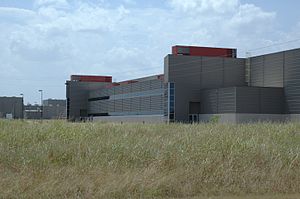Superconducting Supercollider

SSC site, 2008
|
|
| Intersecting Storage Rings | CERN, 1971–1984 |
|---|---|
| Super Proton Synchrotron | CERN, 1981–1984 |
| ISABELLE | BNL, cancelled in 1983 |
| Tevatron | Fermilab, 1987–2011 |
| Relativistic Heavy Ion Collider | BNL, 2000–present |
| Superconducting Super Collider | Cancelled in 1993 |
| Large Hadron Collider | CERN, 2009–present |
| Future Circular Collider | Proposed |
The Superconducting Super Collider (SSC) (also nicknamed the Desertron) was a particle accelerator complex under construction in the vicinity of Waxahachie, Texas.
Its planned ring circumference was 87.1 kilometers (54.1 mi) with an energy of 20 TeV per proton and was set to be the world's largest and most energetic. It would have greatly surpassed the current record held by the Large Hadron Collider which has ring circumference 27 km (17 mi) and energy of 6.5 TeV per proton. The project's director was Roy Schwitters, a physicist at the University of Texas at Austin. Dr. Louis Ianniello served as its first Project Director for 15 months. The project was cancelled in 1993 due to budget problems.
The system was first formally discussed in the December 1976 National Reference Designs Study, which examined the technical and economic feasibility of a machine with the design capacity of 20 TeV per proton.Fermilab director and subsequent Nobel physics prizewinner Leon Lederman was a very prominent early supporter – some sources say the architect or proposer – of the Superconducting Super Collider project, which was endorsed around 1983, and a major proponent and advocate throughout its lifetime.
An extensive U.S. Department of Energy review was done during the mid-1980s. Seventeen shafts were sunk and 23.5 km (14.6 mi) of tunnel were bored by late 1993.
During the design and the first construction stage, a heated debate ensued about the high cost of the project. In 1987, Congress was told the project could be completed for $4.4 billion, and it gained the enthusiastic support of Speaker Jim Wright of nearby Fort Worth, Texas. A recurring argument was the contrast with NASA's contribution to the International Space Station (ISS), a similar dollar amount. Critics of the project (Congressmen representing other US states and scientists working in non-SSC fields who felt the money would be better spent on their own fields) argued that the US could not afford both of them. Early in 1993 a group supported by funds from project contractors organized a public relations campaign to lobby Congress directly, but in June, the non-profit Project on Government Oversight released a draft audit report by the Department of Energy's Inspector General heavily criticizing the Super Collider for its high costs and poor management by officials in charge of it.
...
Wikipedia
